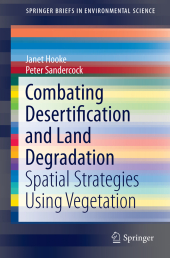 Neuerscheinungen 2017Stand: 2020-02-01 |
Schnellsuche
ISBN/Stichwort/Autor
|
Herderstraße 10
10625 Berlin
Tel.: 030 315 714 16
Fax 030 315 714 14
info@buchspektrum.de |

Janet Hooke, Peter Sandercock
(Beteiligte)
Combating Desertification and Land Degradation
Spatial Strategies Using Vegetation
1st ed. 2017. 2017. x, 135 S. 8 SW-Abb., 34 Farbabb. 235 mm
Verlag/Jahr: SPRINGER, BERLIN; SPRINGER INTERNATIONAL PUBLISHING 2017
ISBN: 3-319-44449-2 (3319444492)
Neue ISBN: 978-3-319-44449-9 (9783319444499)
Preis und Lieferzeit: Bitte klicken
This book reports an approach developed to research and apply methods of assessing patterns of processes in the landscape, and suitability of different types of vegetation to mitigate soil erosion and sediment flux. Practical guidelines on a spatially strategic approach to management of land degradation at a range of spatial scales were produced. Originally developed for the Mediterranean environment, it has much wider potential global application. It provides researchers with methods to acquire the knowledge necessary for such an approach and provides practitioners with guidance on implementation and benefits of targeted methods of soil erosion control. It includes substantial information about processes and vegetation in the Mediterranean environment and the species effectiveness in soil erosion control.
This book reports an approach developed to research and apply methods of assessing patterns of processes in the landscape, and suitability of different types of vegetation to mitigate soil erosion and sediment flux. Practical guidelines on a spatially strategic approach to management of land degradation at a range of spatial scales were produced. Originally developed for the Mediterranean environment, it has much wider potential global application. It provides researchers with methods to acquire the knowledge necessary for such an approach and provides practitioners with guidance on implementation and benefits of targeted methods of soil erosion control. It includes substantial information about processes and vegetation in the Mediterranean environment and the species effectiveness in soil erosion control.
Chapter 1 INTRODUCTION.- 1.1 Context and problem.-1.2 Processes and connectivity concept.-1.3 Benefits of use of vegetation.- 1.4 Approach.- 1.5 Research design and study area.- 1.6 Conclusion.-Chapter 2 MECHANISMS OF DEGRADATION AND IDENTIFICATION OF CONNECTIVITY AND EROSION HOTSPOTS.- 2.1 Soil erosion and degradation in desertified Mediterranean lands.- 2.2 Processes.- 2.3 Connectivity concept and methods.- 2.4 Methods and results at various scales.- 2.5 Conclusions.-Chapter 3 CONDITIONS FOR GROWTH OF PLANTS.- 3.1 Introduction.- 3.2 Types of plants in Mediterranean environment and land units.-3.3 Assessment of conditions for plants.-3.4 Summary of results on required conditions and implications for restoration.-Chapter 4 EFFECTIVENESS OF PLANTS AND VEGETATION IN EROSION CONTROL AND RESTORATION.- 4.1 Introduction.- 4.2 Land units.- 4.3 Role of plants in reducing concentrated flow erosion rates.- 4.4 Effects of vegetation in channels.- 4.5 Summary.- Chapter 5 SYNTHESIS AND APPLICATION OF SPATIAL STRATEGIES FOR USE OF VEGETATION TO MINIMISE CONNECTIVITY.-5.1 Introduction.- 5.2 Application at hierarchical scales.- 5.3 Guidelines.- 5.4 Summary.- 5.5 Wider application and global implications.- REFERENCES.
Chapter 1 INTRODUCTION.- 1.1 Context and problem.-1.2 Processes and connectivity concept.-1.3 Benefits of use of vegetation.- 1.4 Approach.- 1.5 Research design and study area.- 1.6 Conclusion.-Chapter 2 MECHANISMS OF DEGRADATION AND IDENTIFICATION OF CONNECTIVITY AND EROSION HOTSPOTS.- 2.1 Soil erosion and degradation in desertified Mediterranean lands.- 2.2 Processes.- 2.3 Connectivity concept and methods.- 2.4 Methods and results at various scales.- 2.5 Conclusions.-Chapter 3 CONDITIONS FOR GROWTH OF PLANTS.- 3.1 Introduction.- 3.2 Types of plants in Mediterranean environment and land units.-3.3 Assessment of conditions for plants.-3.4 Summary of results on required conditions and implications for restoration.-Chapter 4 EFFECTIVENESS OF PLANTS AND VEGETATION IN EROSION CONTROL AND RESTORATION.- 4.1 Introduction.- 4.2 Land units.- 4.3 Role of plants in reducing concentrated flow erosion rates.- 4.4 Effects of vegetation in channels.- 4.5 Summary.- Chapter 5 SYNTHESIS AND APPLICATION OF SPATIAL STRATEGIES FOR USE OF VEGETATION TO MINIMISE CONNECTIVITY.-5.1 Introduction.- 5.2 Application at hierarchical scales.- 5.3 Guidelines.- 5.4 Summary.- 5.5 Wider application and global implications.- REFERENCES.


